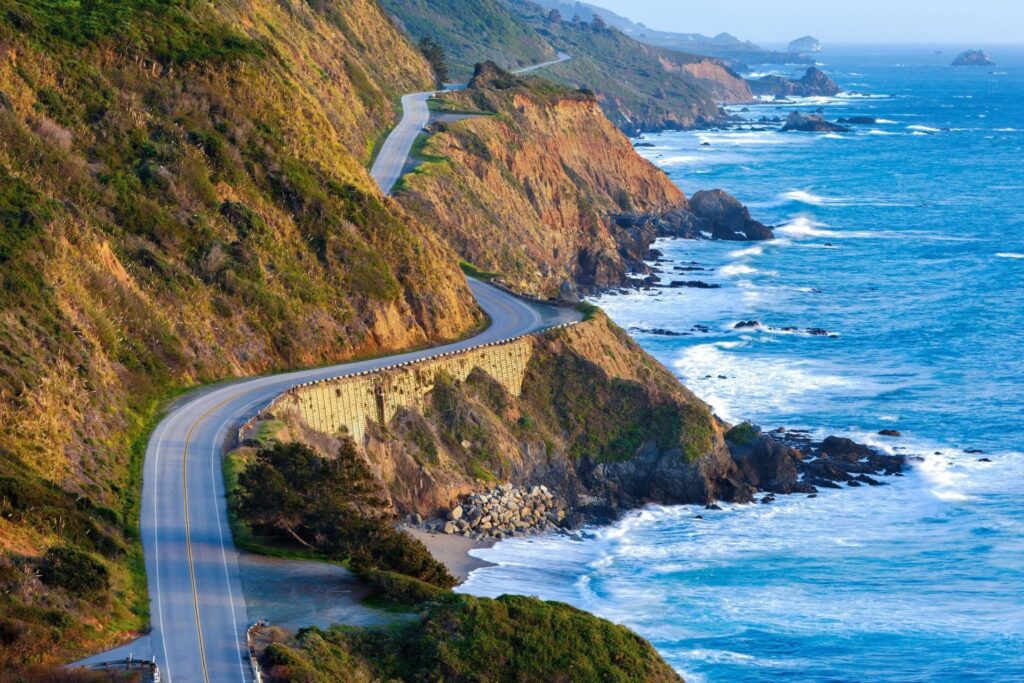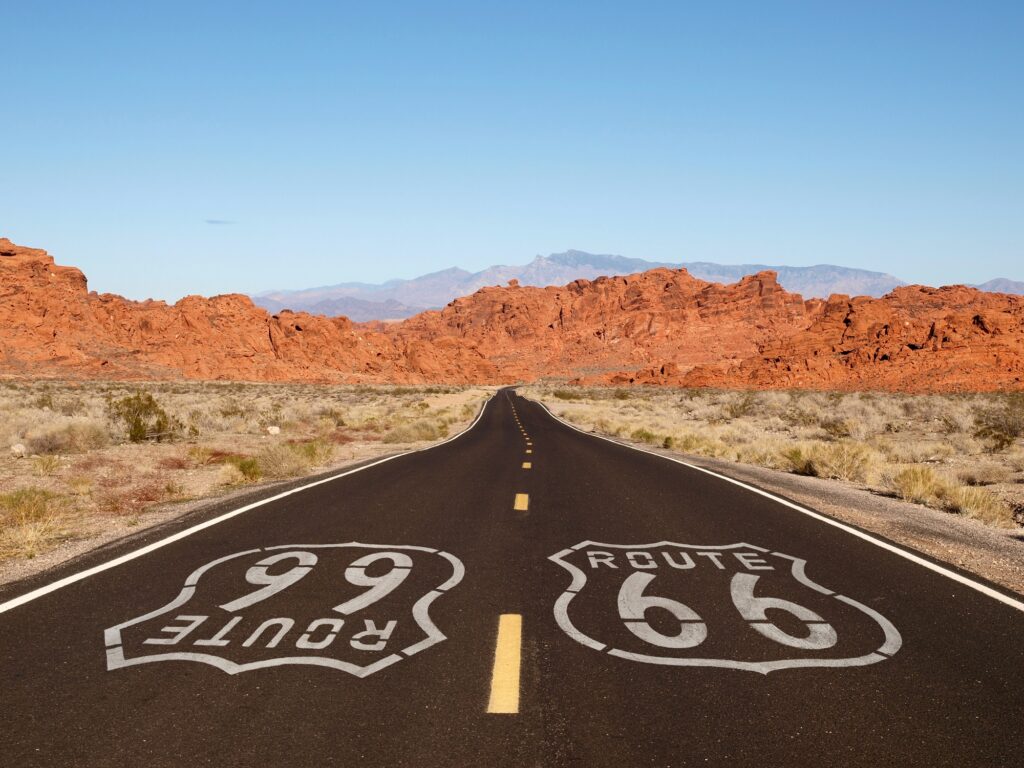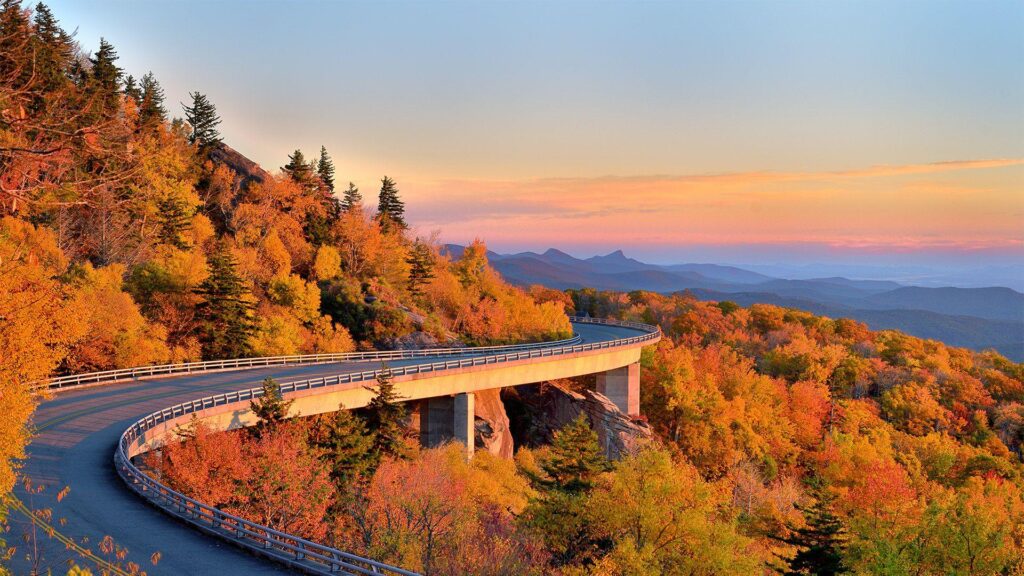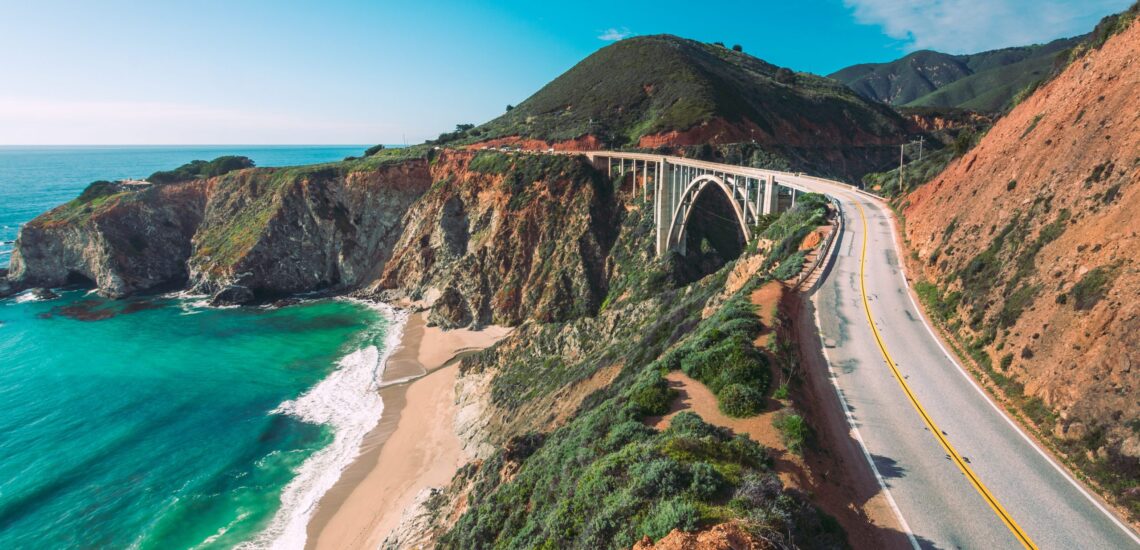Car or motorbike travel offers the flexibility to explore scenic routes, charming towns, and picturesque landscapes at your own pace. Here is the #3 destinations for car travelers in the United States.
Useful tips before you go
- If you are coming from outside the US – do not forget about obtaining or renewing an International Driving Permit
- Make sure you find the best deal on local car rentals and book your vehicle in advance.
- Get a travel sim card and save on Internet wherever you go.
- Find and compare prices on more than 250,000 hotels in 205 countries around the world using the data from more than 10 online booking systems, such as Agoda.com, Hotels.com, Expedia, and others
- Select a desired activity among more than 300,000 experiences throughout 200 countries, including wine tastings, walking tours, cooking classes, catamaran rides, tickets and passes to popular landmarks
№1 Pacific Coast Highway (PCH), USA
The Pacific Coast Highway, or California State Route 1, is one of the most scenic drives in the United States. Stretching over 600 miles from Dana Point in Southern California to Leggett in Northern California, this iconic route offers breathtaking ocean views, quaint coastal towns, and unique landmarks. Here’s a comprehensive guide to exploring the Pacific Coast Highway by car.

Planning Your Trip
- Best Time to Visit: The PCH is accessible year-round, but the best time to visit is during late spring to early fall, when the weather is mild and clear.
- Route Direction: Most travelers start from the south (Dana Point) and head north. This direction offers the best views, as you’ll be on the side closest to the ocean.
- Duration: The full route can be driven in about 10–12 hours, but it’s best to plan for at least 3–5 days to explore key landmarks and enjoy the journey.
- Renting a Car: You can rent a car at Los Angeles International Airport (LAX), San Francisco International Airport (SFO), or other major California airports. Look for a vehicle with good fuel efficiency and reliable GPS.
Must-See Landmarks
- Santa Monica Pier:
- The iconic pier with an amusement park, Ferris wheel, and restaurants. Great for a start to your journey.
- Malibu:
- Known for its beautiful beaches, celebrity homes, and iconic spots like the Malibu Pier.
- Point Mugu Rock:
- A dramatic coastal rock formation and popular photo spot.
- Santa Barbara:
- A charming coastal town with a historic mission, botanic garden, and vibrant downtown area.
- Hearst Castle:
- A historic estate with opulent architecture and art collections. Guided tours are available.
- Morro Bay:
- Known for its iconic Morro Rock and diverse birdlife. A great place to take a break.
- Big Sur:
- The crown jewel of the PCH, offering rugged cliffs, waterfalls, and panoramic views. Don’t miss Bixby Bridge and McWay Falls.
- Carmel-by-the-Sea:
- A picturesque village with art galleries, boutique shops, and quaint architecture.
- Monterey:
- Home to the Monterey Bay Aquarium and historic Cannery Row.
- Half Moon Bay:
- A beautiful coastal town known for its pumpkin festival and scenic beaches.
Useful Tips
- Fuel and Supplies: Fill up on gas before entering Big Sur, as fuel stations are sparse in this area. Stock up on snacks and water for the journey.
- Drive Safely: The PCH has winding roads and steep cliffs. Drive at a safe speed, especially in foggy conditions.
- Photography Stops: There are numerous turnouts along the highway for photography and scenic views. Take your time to enjoy these spots.
- Accommodation: Book accommodation in advance, especially during peak tourist seasons. Consider staying in Santa Barbara, Carmel, or Monterey for overnight stops.
- Weather Conditions: Check the weather before you go, especially in winter, as landslides or road closures can affect the route.
- Respect Nature: Stay on designated paths and be mindful of wildlife and natural habitats.
With this guide, you’re ready to explore the Pacific Coast Highway, taking in the stunning landscapes and unique attractions along the way. Enjoy the journey!
№2 The Ultimate Road Trip: Exploring Route 66, USA
Route 66, often referred to as the “Main Street of America” or the “Mother Road,” is an iconic symbol of Americana and the quintessential road trip experience. Stretching approximately 2,448 miles from Chicago, Illinois, to Santa Monica, California, this historic highway offers travelers a unique glimpse into the heart and soul of the United States. Embarking on a journey along Route 66 is not just about reaching a destination; it’s about relishing the journey itself, with all its charming towns, quirky roadside attractions, and picturesque landscapes.

A Journey Through Time
Route 66 was established on November 11, 1926, and quickly became a major pathway for those migrating west, especially during the Dust Bowl of the 1930s. The highway passed through eight states: Illinois, Missouri, Kansas, Oklahoma, Texas, New Mexico, Arizona, and California. Each state contributes its unique flavor to the journey, offering a diverse array of experiences and sights.
Starting Point: Chicago, Illinois
Your adventure begins in Chicago, Illinois, a vibrant city with a rich history. Before hitting the road, take some time to explore Chicago’s iconic landmarks, such as Millennium Park, the Art Institute of Chicago, and Navy Pier. Once you’re ready, head to the Route 66 starting point at the corner of Adams Street and Michigan Avenue, where a sign marks the beginning of this legendary journey.
Illinois: Small Town Charm
As you leave the bustling city of Chicago, you’ll soon find yourself immersed in the quaint charm of small-town America. The road takes you through cities like Joliet, where you can visit the Joliet Route 66 Museum, and Pontiac, home to the Route 66 Hall of Fame and Museum. Don’t miss the Gemini Giant in Wilmington, a classic example of the quirky roadside attractions that dot Route 66.
Missouri: Gateway to the West
Crossing into Missouri, you’ll encounter the Gateway Arch in St. Louis, a symbol of westward expansion. Route 66 winds through rolling hills and scenic countryside, leading you to towns like Cuba, known for its vibrant murals, and Lebanon, where you can stay at the historic Munger Moss Motel.
Kansas: Short but Sweet
The Kansas stretch of Route 66 is only 13 miles long, but it’s packed with nostalgia. Galena, Riverton, and Baxter Springs offer charming glimpses of the past, with restored service stations, vintage diners, and friendly locals eager to share their stories.
Oklahoma: The Heartland
Oklahoma boasts the longest drivable stretch of Route 66, offering a mix of urban and rural experiences. Visit the Oklahoma Route 66 Museum in Clinton, explore the Blue Whale of Catoosa, and enjoy the vibrant arts scene in Tulsa. The state is also home to the National Route 66 Museum in Elk City, a must-see for any Route 66 enthusiast.
Texas: The Panhandle
As you enter Texas, you’ll be greeted by the vast plains of the Panhandle. Amarillo is a highlight, featuring the famous Cadillac Ranch, where you can add your mark to the spray-painted car sculptures. Enjoy a hearty steak at the Big Texan Steak Ranch, known for its 72-ounce steak challenge.
New Mexico: The Land of Enchantment
New Mexico’s portion of Route 66 is rich with Native American culture and stunning landscapes. Santa Fe offers a detour worth taking, with its unique adobe architecture and vibrant arts scene. Albuquerque, with its historic Old Town and the annual International Balloon Fiesta, is another highlight.
Arizona: Desert Wonders
Arizona’s Route 66 is marked by breathtaking desert scenery and the Grand Canyon. Visit the Petrified Forest National Park, explore the quirky town of Winslow made famous by the Eagles’ song “Take It Easy,” and stop by the historic La Posada Hotel in Flagstaff. The route also takes you through Seligman, a town that inspired the movie “Cars.”
California: The Journey’s End
As you cross into California, the end of your journey draws near. Pass through the Mojave Desert and the ghost town of Amboy before reaching the bustling city of Los Angeles. The final stop on Route 66 is the Santa Monica Pier, where a sign marks the end of the trail. Take a moment to reflect on your journey and enjoy the Pacific Ocean’s serene beauty.
Tips for the Trip
- Plan Ahead: While spontaneity is part of the charm, having a rough itinerary helps ensure you don’t miss key attractions.
- Stay Hydrated: Especially in the desert regions, keep plenty of water on hand.
- Capture Memories: Bring a good camera to document the unique sights and experiences.
- Embrace the Quirky: From roadside diners to eccentric museums, Route 66 is full of surprises. Embrace the unexpected and enjoy the ride.
Conclusion
Traveling Route 66 is more than just a road trip; it’s a journey through the history, culture, and spirit of America. Whether you’re a seasoned road tripper or a first-time adventurer, the Mother Road offers an unforgettable experience that captures the essence of the American dream. So pack your bags, fuel up your car, and get ready to hit the open road—Route 66 awaits!
№3 Exploring the Blue Ridge Parkway by Car or Motorbike
Nestled in the heart of the Appalachian Mountains, the Blue Ridge Parkway is a journey that transcends the ordinary road trip. Stretching 469 miles from Virginia’s Shenandoah National Park to North Carolina’s Great Smoky Mountains National Park, this scenic byway offers an unparalleled experience for those seeking to immerse themselves in nature’s splendor, whether by car or motorbike.

The Ultimate Scenic Drive
Spectacular Views at Every Turn The Blue Ridge Parkway is renowned for its breathtaking vistas, with numerous overlooks providing panoramic views of rolling mountains, verdant valleys, and colorful forests. For drivers and riders alike, each twist and turn reveals new landscapes, from the lush greenery of summer to the vibrant hues of fall foliage. Key overlooks such as Mabry Mill, Linville Gorge, and Waterrock Knob offer perfect spots to pause and soak in the scenery.
Historic and Cultural Stops Along the parkway, travelers will find a wealth of historical and cultural sites that offer a glimpse into the region’s rich heritage. The Blue Ridge Music Center celebrates the musical traditions of the Appalachian region, while the Peaks of Otter area boasts historic farms and structures that date back to the early 19th century. The Parkway Craft Center at Moses H. Cone Memorial Park showcases the work of local artisans, providing an opportunity to purchase unique handcrafted souvenirs.
Nature and Wildlife The parkway is a haven for nature enthusiasts, with abundant opportunities for wildlife viewing and outdoor activities. Deer, black bears, and a variety of bird species are commonly spotted along the route. Numerous trails, ranging from short walks to challenging hikes, lead to waterfalls, scenic viewpoints, and pristine natural areas. Popular trails include the Humpback Rocks Trail, Crabtree Falls Loop, and the strenuous trek to the summit of Mount Mitchell, the highest peak east of the Mississippi River.
The Joy of the Ride
Driving the Parkway Exploring the Blue Ridge Parkway by car is a comfortable and accessible way to experience its beauty. The road is well-maintained and features numerous pull-offs where drivers can stop to take photos, have a picnic, or simply enjoy the view. The leisurely pace of the parkway, with a speed limit of 45 mph or less, allows for a relaxed and unhurried journey. Be sure to pack a picnic, as there are many scenic spots perfect for a meal with a view.
Riding the Parkway on a Motorbike For motorbike enthusiasts, the Blue Ridge Parkway is a dream come true. The road’s winding curves, gentle slopes, and smooth pavement make for an exhilarating ride. Motorcyclists can feel the rush of the open road while being enveloped by the sights, sounds, and smells of the Appalachian wilderness. Remember to gear up appropriately and ride safely, as weather conditions can change rapidly in the mountains.
Practical Tips for Your Journey
Planning Your Trip Before setting out on your adventure, it’s essential to plan your route and accommodations. While the parkway itself offers numerous campgrounds and picnic areas, nearby towns and cities provide additional lodging options ranging from rustic cabins to cozy bed-and-breakfasts. It’s also wise to check the Blue Ridge Parkway’s official website for updates on road conditions and closures, as certain sections may be inaccessible during winter months or due to maintenance work.
Packing Essentials Whether traveling by car or motorbike, packing the right gear is crucial for a comfortable and enjoyable trip. Essentials include:
- Clothing: Layered clothing to accommodate changing temperatures.
- Safety Gear: Helmets and protective gear for motorcyclists.
- Maps and Guides: Detailed maps and travel guides to navigate the parkway and locate points of interest.
- Food and Water: Snacks and plenty of water, as services along the parkway can be limited.
- Camera: A good camera or smartphone to capture the stunning scenery.
Respecting the Parkway As one of America’s most treasured scenic routes, the Blue Ridge Parkway deserves respect and care from all who travel it. Be mindful of the environment by staying on designated paths, disposing of trash properly, and observing wildlife from a safe distance. Respecting speed limits and road rules ensures that everyone can enjoy the parkway safely.
Conclusion
Exploring the Blue Ridge Parkway by car or motorbike is an unforgettable experience that offers a unique blend of natural beauty, cultural richness, and thrilling adventure. Whether you’re a nature lover, history buff, or road trip enthusiast, the parkway promises a journey filled with wonder and discovery. So, pack your bags, start your engines, and embark on a scenic adventure through one of America’s most iconic landscapes.

Published July 31, 2024 • 13m to read


